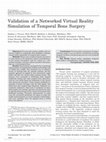Papers by Alexander Krumpholz
The Laryngoscope, 2008
To assess the content validity and concurrent validity of a haptically (force feedback) rendered,... more To assess the content validity and concurrent validity of a haptically (force feedback) rendered, virtual reality simulation of temporal bone surgery.

Australasian Journal of Information Systems, 2007
We report on a care setting where staff looking after ex-psychiatric hospital patients used mobil... more We report on a care setting where staff looking after ex-psychiatric hospital patients used mobile and stationary communications technology (e.g. mobile phones and a messaging system) and physical artefacts (e.g. whiteboards and Post-It notes). Building on previous ethnographic investigations, we show that the concept of trajectory (or an ongoing course of action) was important when generating a particular understanding of staff's care work. We argue that sensitivity to this concept and related subconcepts was helpful in identifying the key transitions, cycles, plans and management issues in staff's ongoing work. We present verified trajectory-informed scenarios and themes emerging from fieldwork and show that the snapshots of work described in the scenarios were useful for establishing current and future interactional needs among staff and residents. We also show how trajectory helped ground a design for a situated display. Finally, we describe the strengths and benefits of trajectory as 'a way of looking' in fieldwork aimed at socio-technical system design in settings where supporting collective, ongoing, contingent care is important.

Virtual Reality, Jan 1, 2006
Networked virtual environments using haptic interfaces can be used for surgical training and supp... more Networked virtual environments using haptic interfaces can be used for surgical training and support both a simulation component and a communication component. We present such an environment for training in surgery of the temporal bone, which emphasises communication between an instructor and a student. We give an overview of the learning requirements for surgeons in this area and present the details of our implementation with a focus on the way communication is supported. We describe a training trial that was undertaken with a group of surgical trainees and carry out a qualitative analysis of transcripts from the teaching sessions. We conclude that the virtual environment supports a rich dialogue between the instructor and student, allowing them to ground their conversation in the shared model. Haptic interfaces are an important enabling technology for the simulation and communication and are used in conjunction with other modes and media to support situated learning.
Proceedings of the …, 2005
Networked collaborative virtual reality systems have been proposed for surgical education. They a... more Networked collaborative virtual reality systems have been proposed for surgical education. They allow an instructor to teach a student using a shared virtual model, even if separated by distance. For these systems to be accepted within the surgical community there must be a ...
IUI 2006 Workshop …, Jan 1, 2006

The …, Jan 1, 2008
Objectives: To assess the content validity and concurrent validity of a haptically (force feedbac... more Objectives: To assess the content validity and concurrent validity of a haptically (force feedback) rendered, virtual reality simulation of temporal bone surgery.Methods: Eleven naive surgical trainees were given a 1-hour lesson on the operation, cortical mastoidectomy, in the virtual environment with the trainer on a networked simulator and then asked to perform this procedure on a real temporal bone.Results: The simulator was found to be a convincing representation of temporal bone drilling and could be said to exhibit face validity. The simulator was an effective means of teaching both the surgical anatomy and the surgical approach as judged by oral assessments made before and after the virtual reality training session. The trainees were successful in identifying most surgical landmarks during their first temporal bone dissection, and over two thirds found the landmarks at the correct time during the procedure. Some trainees exhibited acceptable or better technique with the drill despite this being their first temporal bone dissection. Subjective assessments indicated a high level of acceptance of simulated surgery for training, and there was perceived value in specific enhancements of the virtual environment that facilitated learning. Particular enhancements of value were the networked simulation, the option to make the model semitransparent to reveal anatomic relationships, and error reporting when the sigmoid sinus or facial nerve was injured.Conclusions: Virtual reality simulation of temporal bone surgery was an effective method for teaching surgical anatomy and planning and was well accepted by trainees.
Studies in Health …, Jan 1, 2005
This paper describes a computer system for teaching temporal bone surgery using networked haptic ... more This paper describes a computer system for teaching temporal bone surgery using networked haptic work benches. The system enables an instructor and student to collaboratively explore and drill a volumetric bone model including significant anatomical features. Subjective evaluations by otologists have been favourable, and experimental trials are planned.
Australasian Medical Journal, 2012
The constantly growing publication rate of medical research articles puts increasing pressure on ... more The constantly growing publication rate of medical research articles puts increasing pressure on medical specialists who need to be aware of the recent developments in their field. The currently used literature retrieval systems allow researchers to find specific papers; however the search task is still repetitive and time--consuming.









Uploads
Papers by Alexander Krumpholz